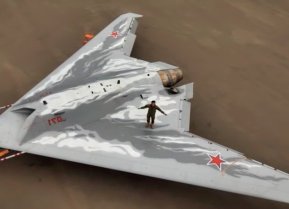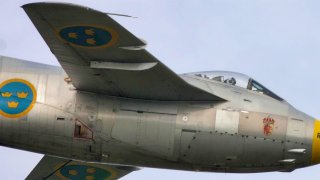Saab J29 Tunnan: Why Sweden's Barrel Fighter Was Such a Game Changer
The Saab J29 Tunnan entered service in 1951 and was well suited to serving in both fighter and fighter-bomber roles. The S29C was a reconnaissance variant – "S" deriving from the "spaning" or "scouting" in Swedish – and the 76 models built were fitted with five cameras mounted in a modified nose. H
J29 Tunnan: Meet the Only Swedish Aircraft to Go to War - As Sweden is now set to join NATO there is a chance that its military aircraft could be deployed in a future conflict.
Months back, there was some talk that the fourteen JAS 39 "Gripen" fighter jets in service with the Czech Air Force could be provided to Ukraine.
The catch is that Kyiv wouldn't actually be provided any of the aircraft until the lease with Prague expires in 2027, and then only if Stockholm doesn't agree to upgrade those fighters to the current E/F version.
Yet, as it currently stands, the Czech military has sought to acquire the Lockheed Martin F-35 Lightning II, which likely means that the Swedish aircraft could be deployed to Ukraine – at least eventually. That could still be notable, as few of the Swedish-designed warbirds of the Cold War era actually saw combat.
In fact, while Stockholm produced a number of advanced aircraft to counter a potential invasion from the Soviet Union, only one Swedish fighter was ever sent to a combat zone. It was the Saab J29 Tunnan, which deployed to the former Belgian Congo as part of the United Nations (UN) peacekeeping forces – the UN ONUC ("Organisation des Nations Unies au Congo") – from 1961 to 1964.
That action was the UN's first considerable military operation in Africa.
Sweden's Barrel Goes to War
The deployment also marked the first and last exposure to combat for the J29 "Tunnan" (Swedish for "Barrel"), and while the jungle terrain of Central Africa differed greatly from Scandinavia, the fighter-bomber was used effectively to strike at enemy ground targets, providing both cannon fire and rockets with no recorded losses. Five aircraft had been first deployed to the Congo in early 1961, and its main mission was to protect the UN's air transport, and, only if necessary, to provide fire support.
What is also noteworthy is that the Swedish unit accounted for the UN mission's entire aerial support, but was seen as insufficient to accomplish the mission. As the fighting flared up in early 1962, an additional four Saab Tunnan J29Bs and two S29C reconnaissance aircraft were added to the force.
It was a brief mission, however.
The UN squadron was actually disbanded in April 1963, and the last remaining Swedes returned home later that year. Interestingly, following the UN operations, the aircraft deployed to Congo were scrapped rather than being relocated back to Sweden due to the issue of cost.
Saab J29: World War II Origins
By the time of the deployment in Africa, the Saab J29 was already showing its age. Designed in the late 1940s, it was the second turbojet-powered combat aircraft to be developed in Sweden, after the Saab 21R, but more importantly, it was the first swept-wing fighter to be built in Europe. Sweden had relied on World War II German studies involving the swept wings, and it is easy to see the influence of the Luftwaffe's Messerschmitt M3 P1101 project.
In addition, the availability of the British Ghost turbojet enabled noted Swedish aviation pioneer Lars Brising and his design team to raise their sights and go for higher performance while employing a swept wing – with a wing layout that swept 25 degrees rearward – in the new aircraft. The first generation jet fighter was a single-seat, single-engine aircraft with a single central air take placed at the nose and a bubble cockpit.
The J29 Tunnan entered service in 1951 and was well suited to serving in both fighter and fighter-bomber roles. The S29C was a reconnaissance variant – "S" deriving from the "spaning" or "scouting" in Swedish – and the 76 models built were fitted with five cameras mounted in a modified nose. However, that particular model lacked any armament, so it was generally escorted by the J29 aircraft.
The Tunnan in all configurations remained in operation until the early 1970s, and during those two decades was regularly updated, which further improved its performance. A total of 661 Saab J29 Tunnans were delivered, and many of the 308 B, D, and E models were upgraded to the J29F standards.
Just three Tunnans – in their J29F configurations – remain, while the rest have been scrapped over the years. One that was in service with the Austrian Air Force is on display at the Museum of Military History in Vienna, while another is at the French Musée de l'Air located at the former Paris–Le Bourget Airport and the third is at the Swedish Cold War "Aeroseum" in Göteborg. That aircraft has been painted to resemble the nearly dozen J29s that went to war in the Congo.
About the Author
Peter Suciu is a Michigan-based writer who has contributed to more than four dozen magazines, newspapers and websites. He regularly writes about military hardware, firearms history, cybersecurity and international affairs. Peter is also a Contributing Writer for Forbes. You can follow him on Twitter: @PeterSuciu.


